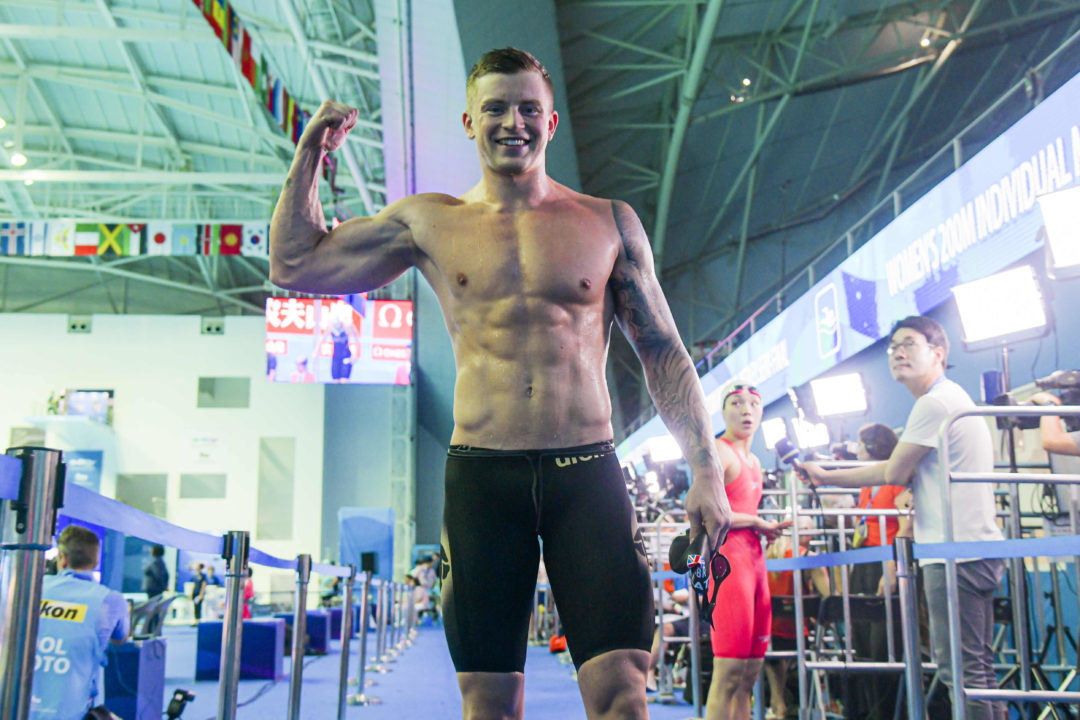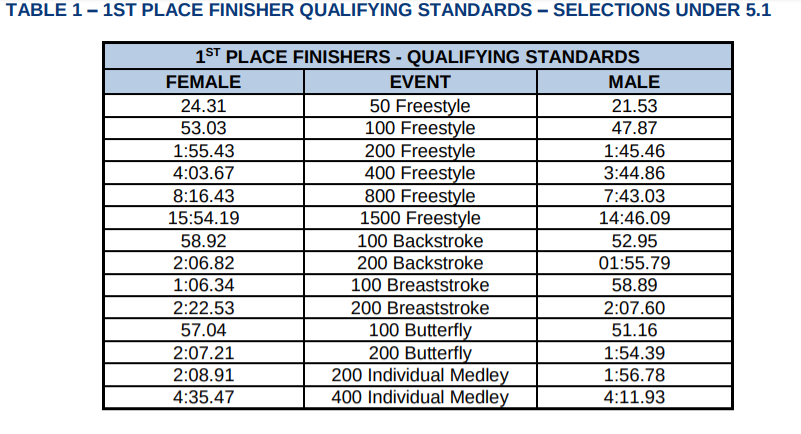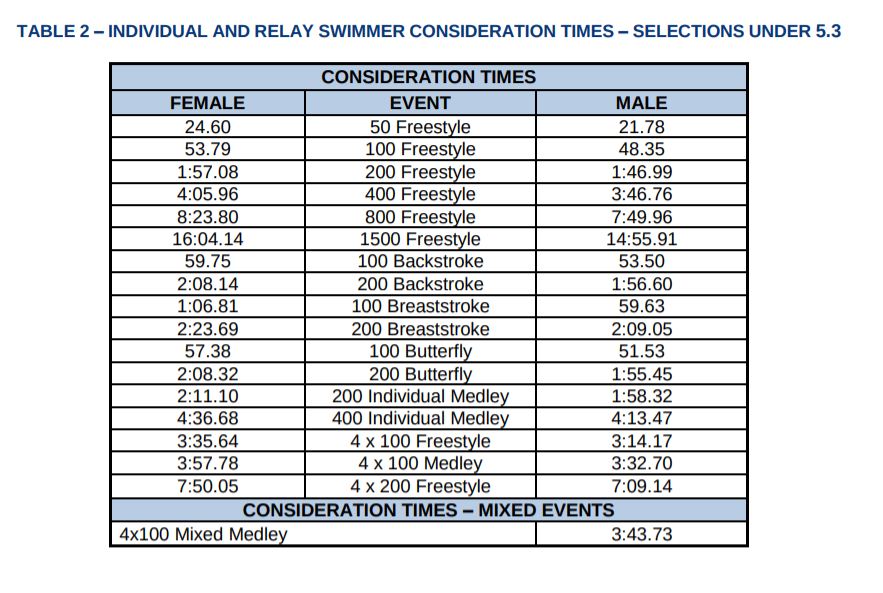In September we reported the British Swimming Selection Policy for the 2020 Olympic Games coaching staff, but now it’s the athletes’ turn to get a look at what it will take to book a ticket to the big show in Tokyo.
As in 2016, the qualification times set forth by British Swimming are tough, intended to bring only the truly medal-worthy individual swimmers and relay participants to represent the nation next summer.
British Swimming 2020 Olympic Games Selection Policy
The sole official selection meet is the 2020 British Swimming Championships slated for the London Aquatics Centre April 14th – April 19th. You can catch up on our analysis of the qualifying times to even get into that meet here.
As in 2016, British Swimming has set-up a tiered approach to qualification, with the top finisher in each individual event earning a roster spot as long as he/she meets or exceeds the stiff qualification time listed in the first table below in the Open Final of the aforementioned competition.
After that, a maximum of 8 additional nominations, up from 6 in 2016, may be made at the discretion of the National Performance Director and GB Head Coach, partly based on the outcome of times achieved in Table 2 below. An athlete meeting or exceeding the time listed in Table 2 from the Open Final at the British Swimming Championships may be considered for nomination, but selection is not guaranteed. A maximum of 30 athletes may comprise the roster.
The selection process reads as fairly straightforward, that is until you take a look at the tough times required. The 1st Place Finishers time table carries times ranging from 1.3-2.0% faster than the FINA ‘A’ standard, with several marks sitting inside of the British National Record. Those specific QTs are as follows:
Men’s QTs Sitting Inside National Record:
- Men’s 100 free QT of 47.87 = NR of 47.87
- Men’s 800 free QT of 7:43.03 is faster than NR of 7:44.32
- Men’s 200 fly QT of 1:54.39 is faster than NR of 1:54.58
Women’s QTs Sitting Inside National Record:
- Women’s 200 free QT of 1:55.43 is faster than NR of 1:55.54
- Women’s 100 breast QT of 1:06.34 = National Record
- Women’s 100 fly QT of 57.04 is faster than NR of 57.25
Although not beating the British Record, several additional times come extremely close to that, including the men’s 200m back, whose QT is 1:55.79 with the NR sitting at 1:55.58. The same holds true for the men’s 200m IM, whose QT is 1:56..78, just .14 off of the 1:56.64 NR.
For the women, the 200m back QT of 2:06.82 is within a hair of the 2:06.66 NR, for example.
As far as relay selection goes, the following British relay squads earned automatic berths to the Olympic Games at least so far as having finished in the top 10 at this summer’s World Championships: Women’s 4x100m medley, Men’s 4x100m free, Men’s 4x200m free, Men’s 4x100m medley, Mixed Medley.
However, the British Swimming 2020 Olympic Games Selection Policy contains stipulations regarding the relays. For instance, the top 4 finishers in each of the Opoen Final of the individual 100m and 200m freestyle events at the British Swimming Championships will be ranked as a relay team with a collective time ranked against the ‘Table 2’ QT below. If the collective effort doesn’t qualify, the National Performance Director may use splits from the 2019 World Championships.
For reference, here were the British Swimming qualification times for the 2019 World Championships. In most cases the ‘1st place finisher qualifying standard’ matched the time held by the 5th-7th position within the world rankings, depending on the event.
For the ‘consideration times’, the female events were aligned with the 11th-13th position within the world rankings, depending on the event, whereas the men’s fell anywhere from 1oth to 24th based on the event.
Of the 2020 Tokyo Olympic Games qualification times, National Performance Director Chris Spice states,“We are now into the home straight as we head towards another Olympic Games and whilst we are in a good place, there is still much work to be done. The World Championships in July saw us win a number of medals, with some of our emerging talent stepping up and performing well on the big stage. We need to keep this momentum going throughout the next 10 months, with the 2020 British Swimming Championships the key stepping stone along the way.
“As usual our selection policy is geared around winning medals when it matters most, with qualifying times reflecting the level of global swimming at present. Winning medals at Tokyo 2020 will be much harder than this year’s World’s, but we’ll be doing everything we can to ensure our swimmers are as ready as they can be. Already we have seen an ‘Olympic-shift’ in our major centres as we narrow our focus this year, which is a great sign. The minute you stand still is the minute you will be overtaken, so we are looking forward to working with our key coaches and support staff in finding those small margins that may be so crucial in Tokyo. And, of course, we will be working hard to ensure our athletes and staff can enjoy the journey together – it will be an exciting ten months ahead. ”
Great Britain finished 6th in the overall swimming medal table at the 2016 Olympic Games, a finish representing their best in decades. The nation collected a total of 6 medals, including 1 gold, courtesy of Adam Peaty‘s then-World Record-setting 100m breaststroke victory.
Additional individual medals came from now-retired Jazz Carlin who took silver in both the women’s 400m and 800m free, while Siobhan-Marie O’Connor claimed silver in the 200m IM event.



To put this in perspective, the US effectively uses FINA A qualifying times for selection criteria, with the caveat that they must be done at Olympic Trials. Granted, most qualifiers are medal contenders, but that’s not always true. Sometimes you have a weak event where Americans don’t make finals.
Examples… Women’s 200 Fly and occasionally men’s 100/200 breast or distance free
Loretta,
AUS has also released its selection document with QTs
https://www.swimming.org.au/sites/default/files/assets/documents/2020%20Olympic%20Games%20Nomination%20Criteria%20-%20Swimming%20-%20October%202019.pdf
In most cases, they are inside FINA A apart from W200FLY & W400IM. Overall, they could be described as challenging but realistic in that they are “within range” to at least qualify 1 swimmer in almost all events.
Should send it via the contact form in case they don’t notice.
https://swimswam.com/contact-us/
Got it, thanks CommonWombat!
I like the reaction of the girl in red suit to the muscles display on the picture. That is how British swimmers have to impress the selection committee:”Try not to select me….” 😀
FINA allows a country a maximum of 56 swimmers (28 men/women) for Tokyo. What irks me about GBR is they only brought 25 to Gwangju and 26 to Rio. Now they’re maxing out at 30 but based on the past they won’t take that many. Why? Do swimmers 27-30 get in the way or something? Does GBR have data that the 27s to 30s negatively impact the performances of the superstars? The 27 to 30 crowd aren’t by any stretch “tourists”. This is the biggest stage and casual British swim fans and future swimmers watching on their tellies are going to wonder why they won’t see any Brits competing some nights.
Money? Cost of sending them? Australia has just asked their junior swimmers to pay $1000 a year to send them overseas if they make the junior team
But Team GB overall has a huuuuge budget, probably the worlds biggest.
Also the swimmers labelled 27th-30th in GB selection criteria are often not really as some of the slots are taken by relay swimmers who may not be as highly ranked individually. As you said GB are leaving top tier swimmers at home because they have decided coming 5th or 6th at the Olympics isn’t worth it. If everyone did that the logical conclusion is just to run the 100 Free with only Dressel, Chalmers and Grinev. What would be the point. Swimming is a fast changing sport and some people who get locked out at trials on time despite being national champ could by August be in a position where the’d have stepped up and grabbed a bronze. Plus there… Read more »
I’m in favour of stiff qualifying times and, if you haven’t anyone competitive in an event, being prepared to NOT send anyone but some of these times DO probably cross the line as to be punitive. Then again, I will give credit to GBR Swimming for being clear-sighted enough to realise that they don’t have a sufficiently wide spread of talent across either mens or women’s programs and look to which events and which relays have legitimate hopes of “return on investment”. I DO think they need to be judicious with their calls regarding which swimmers with ‘consideration” times/which relays; if its some of the “same old faces” who have questionable records or younger ages. It certainly will be interesting… Read more »
I think you’re missing the point. if you’re the best your country has to offer and you meet the FINA standard then you deserve to go to the Olympics. No ifs or buts. If every country sent only the athletes who stood a reasonable chance of winning a medal, what sort of spectacle do you think it would be?
I admire your altruism but the hard economic reality for most countries; the days of sending “tourists”/someone to “fly the flag” are largely gone. Yes, FINA does have 1-2 events where its rather “open admission” allowing essentially non competitive swimmers from smaller nations “their Olympic moment” but that’s not really in play for the countries we discuss.
Yes, I do agree that GBR Swimming has made this process hopelessly and unnecessarily convoluted but its their prerogative to do so. FINA times are merely a base-line/bare minimum to be accepted. In some events these times ARE indicative of what will be needed to be somewhere near finals, in others they’re probably rather soft.
Also any funding being used for “sending tourists” isn’t being used for development of athletes and there’s already not enough for that.
Its a form of control and bullying of the swimmers.
I am sure the British swimmers are fed up with this nonsense & prefer to avoid any flashback of that nature . Its not like England can afford to play with qualification times like Usa or Russia could & still qualify a solid numbers of swimmers . Ri DI CU LOUS
The issue with this is that most of Britain’s top swimmers can swim those times, but only with a taper (peaty is, as always, the exception). I don’t think James guy is getting under 1:45.4 and 51.1 without a pretty fair amount of rest. At least their trials are in April, but that’s still gonna be a big break in training when instead they could be training through it if the standards weren’t so high.
It also hampers the swimmer right on the edge. Like greenback will have to go a 53.5 in the 100 back, which he will need to pull out all the stops for, leaving him a cycle of about 4 months to get more training in